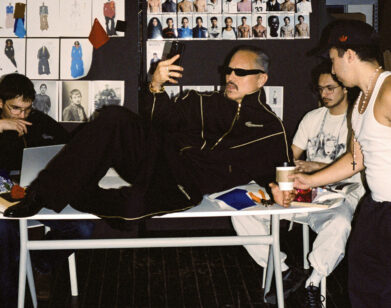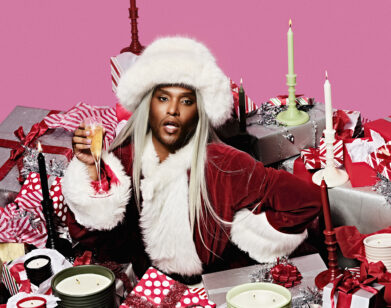Giles Deacon: A Conversation with the Mad Scientist
“Giles, just smile!” reads a sign, drawn in bubble letters, posted behind Giles Deacon’s desk in his London studio. Deacon can be credited with redeeming the house of Ungaro when he was named creative director last May, and recently landed a collaboration with Nine West (due out this fall); he’s also London’s undisputed design darling—so you’d think he wouldn’t need a reminder.
Noted for street-wise glamour and a twisted sense of humor, Deacon’s seven-year-old eponymous line has featured Kate Moss prints, plush dinosaur bags, and multi-colored pompom hats. And the designer, towering at over six feet tall, his silver hair matted down, and lively eyes twinkling behind his signature, oversized Cutler and Gross glasses, Deacon more closely resembles a mad scientist than a fashion designer. That categorization isn’t far from fact: Raised in northern England’s rural Cumbria, Deacon’s boyhood dream was to become a marine biologist. Nonetheless, fate took its course, and after a stint at Bottega Veneta, working with Tom Ford at Gucci, and launching Giles in 2006, Deacon is a rising star, even from the top of London’s rising fashion fortunes.
Entering his sprawling warehouse-turned-studio, one is confronted by floor-to-ceiling inspiration boards, mannequins in half-realized, feather-embellished dresses, Photoshopped images of fanged rabbits, and a flock of stuffed sheep crowned with pastel Stephen Jones feather hats (if you’ll remember, Anna Dello Russo carried one when she modeled in Ungaro’s psychedelic garden presentation last October). What else would one expect from a designer who once sent gargantuan pink Pac-Man helmets down the runway?
Styled by Katie Grand, Deacon’s ex-girlfriend and long-time partner in creative crime, the designer’s fall collection, which made its debut at London’s Royal Courts of Justice on Monday evening, shows a serious side. It featured a strong Victorian edge: stark white blouses nipped at the waist with bondage-inspired leather corsets, boned pearl or goat-hair embellished chokers, and high-gloss black tweed. And there were clever twists, by way of burnt ostrich feathers, which trimmed an ankle-length wool circle skirt and exploded from the side of a Swarovski-studded cocktail dress, shaggy goat hair coats, massive black or white hair bows (perhaps Grand’s influence) and a golden Pre-Raphaelite print.
Interview caught up with Deacon before the show to chat about the new collection, what it’s like to be a straight man in fashion, and those signature specs.
KATHARINE ZARRELLA: How does a marine-biologist wannabe from Cumbria transform into one of the most forward-thinking forces in British fashion?
GILES DEACON: I suppose the marine biology was a post-teen thing. I was kind of on my way but I was one of those teenage boys who got to 13, 14 and had no idea what I was going to do. I liked natural history. I liked the outdoors. And I found the sea quite interesting. But then I discovered lots of music; electronic synth bands from the mid-’80s like Depeche Mode, Soft Cell and Cabaret Voltaire. My friends and I used to take two-hour trips to the record store in Newcastle and we started buying copies of The Face and i-D. And then I went to art school and as time progressed, I ended up where I am now.
ZARRELLA: Do you remember when you first became interested in clothes?
DEACON: Not really, no. I’ve always drawn a lot. I like the idea of turning a 2-D sketch into a 3-D thing very quickly. And clothing is really good for that. You can draw an idea in the morning and you can see it by the end of the day. I think if it were something like a four-month process to get from the idea to the final thing, I would get quite bored.
ZARRELLA: Speaking of drawing, is it true that you got your job at Bottega Veneta because you did a drawing of a car?
DEACON: It is! But it wasn’t just a car drawing. It was a very hilarious drawing of a buggie driving a Roles Royce. But I think there might have been a few other factors involved in getting the job, like possibly having a suitable design C.V.
ZARRELLA: Have you done any recent drawings that aren’t fashion-related?
DEACON: Only personal ones. I sometimes sit and draw people on the bus, or some fantasy hybrid animal. You know, wherever the hand will lead.
ZARRELLA: What’s it like being a straight man in fashion?
DEACON: I don’t ever think about it. It’s fine from my perspective. There are a lot of straight men in fashion, believe it or not. But it’s fine. Journalists seem to be really interested in it.
ZARRELLA: Do you think you understand a woman’s body in a different way than a gay designer does?
DEACON: Yeah, maybe. But that’s such a sweeping generalization. It’s all down to the individual’s intelligence rather than where they slam it.
ZARRELLA: How would you describe the Giles Deacon aesthetic?
DEACON: I like things that are well cut, things that are considered within their detailing. Fabrics that are very developed; specialist jacquards and prints. My clothes are statement pieces. They’re decorative, but there’s always a subversiveness or an othersidedness to them. I like using odd materials or odd components for embroideries. I’ve always liked that Schiaparelli world of playing with unusual objects to make something really beautiful. That’s part of the game. We can do things that are lighthearted and playful but we also do things that are quite dark and sinister. I oscillate between the two.
ZARRELLA: How would you describe this more “serious” new collection for fall?
DEACON: It’s austere. Very disciplined. Lots of super sharp tailoring. Lots of jackets. It’s not prim at all. There’s a lot of black and white, and there’s a very intense teal color, and then a honey-glazed cream. It’s a very strict palette and two really beautiful prints.
ZARRELLA: What was your inspiration?
DEACON: I don’t really look for things in that way. I looked at The Others, that film with Nicole Kidman. I looked at some Victorian pieces. It’s a whole host of things. And there was a lot of drawing.
ZARRELLA: What is the creative dynamic between you and Katie Grand?
DEACON: It’s very intuitive, which is super brilliant and rare. There’s an implicit trust, but it’s not an automatic agreement. She often comes in from a very different angle than what I’ve been thinking about. And that really gives it that extra something, because designers can often get stuck in their own view of how the collection can look. I always love the way that she turns it into something else and I kind of let go at that point.
ZARRELLA: What’s the story behind your glasses?
DEACON: My signature glasses! I like big open frames, and I got to wearing these Cutler and Gross ones a few years ago. I’ve been wearing Cutler and Gross for 15 years, and I know the people there well, so I just keep on getting them in different materials and colors. But I’ve had a couple of Dior pairs on and off in between.
ZARRELLA: You’re going into your second season at Ungaro. How are you finding it—is there a lot to get over?
DEACON: I’m really enjoying it. I feel very at home there. I was really pleased to get that first collection under my belt and out of the way to put all the Lindsay [Lohan] conversations to bed. People always ask me about [Lindsay], and they ask me in a tentative manner, thinking that I wouldn’t want to talk about it and I’m like, I thought it was just as funny as everyone else! It has nothing to do with me! I didn’t put her there. But the team is really good, and it’s going in a good direction.
ZARRELLA: What has been your biggest challenge as a designer?
DEACON: The biggest challenge and the thing I find most enjoyable about being a designer is taking everything in and assimilating it for your perspective, hopefully making it relevant and interesting to people. Making a really beautiful and interesting product, that’s the challenge. And hopefully people find it that way.







